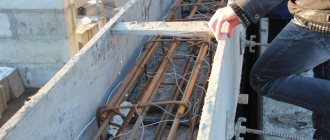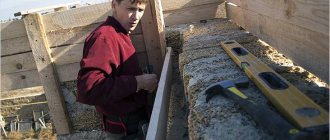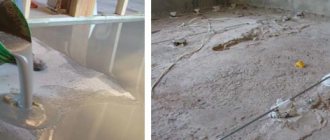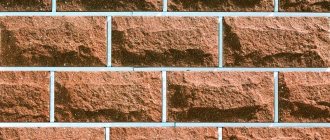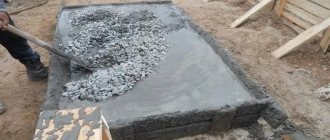Almost every construction site uses concrete; its main indicator is strength, which is not always achieved at the required level. In order for the fresh solution to subsequently gain brand strength within the prescribed period (28 days), ideal conditions for hardening are necessary. But in life at large or private construction projects done with one’s own hands, there are no ideal conditions; most often, concreting is carried out either in the heat or in the cold season.
The concrete surface sets within a few days, but general hardening occurs after 15-20 days (depending on weather conditions)
Why do you need a covering material for concrete, and what is it?
In fact, concrete is used at every construction site; its main indicator is strength, which is not always achieved at the required level. In order for the fresh solution to then gain brand strength within the prescribed period (28 days), perfect conditions for hardening are needed. But in life, on large or private construction projects done with one’s own hands, there are no perfect conditions; much more often, concreting is carried out either in the heat or in winter.
How to prevent chipping and cracking
Concrete care begins with its delivery or mixing at home. The delivery time of the finished solution should be minimal, no more than 1 hour. Filling of the solution must occur immediately after its delivery. It is better to order the mixer in the morning or in the evening, after pouring it, cover it and insulate it.
To avoid cracks in the concrete, it is necessary to equip the correct cushion; it is made using sand or crushed stone. Sand for the pillow needs a medium or coarse fraction, clean, preferably river sand. It is advisable to use granite crushed stone for the base, it is the most durable. The pillow must be carefully compacted - this will prevent shrinkage and subsidence of the structure.
For concreting, medium and large crushed stone with low flakiness is recommended for use. The cube-shaped surface is compacted and does not leave empty spaces in the solution, due to which, in the future, cracks occur.
Another aspect is reinforcing the concrete mass with wire or metal mesh. The reinforcement will not allow the mass to spread out or shrink.
A mistake that all beginners make is adding more water to the cement mixture than is supposed to, supposedly to make mixing easier. This leads to a disruption of the concrete structure, which will negatively affect the quality of the object, its strength and durability. An extra liter of water reduces the quality of the solution by 40%! Concrete that floats is too wet; if it crumbles, it is too dry. The correct consistency resembles high-quality sour cream - a homogeneous, dense, impurity-free, soaked mass.
If a crack does appear, it can be easily repaired with a special compound that is available in hardware stores, or you can repair it yourself. First, the repair site must be cleaned and moistened, and the surface next to the crack must be checked for strength. Mix the required amount of solution, pour and insulate from heat or cold.
Despite the unique characteristics of artificial stone, this material needs protection and care after reaching maximum strength. It is advisable to treat the external elements with special hydrophobic materials to protect them from the external aggressive environment.
Basic prerequisites for using Isofom in monolithic construction
When carrying out concrete work in the autumn and winter seasons, as a rule, contractors face the following main problems:
- the process of freezing of the water contained in concrete, which subsequently causes destruction of the freshly poured concrete structure (during freezing, the volume of ice formed increases by up to 9%);
- significant slowdown of hydration processes in cement mortar;
- the occurrence of temperature cracks caused by the temperature difference inside and outside the poured concrete mixture;
- significant deterioration in the quality of concrete adhesion due to icing of metal elements and the cement base.
Negative impacts of natural factors
Summer heat and winter frosts negatively affect the quality of concrete work. At high air temperatures, rapid evaporation of water from the mixture occurs, which can lead to the cessation of strength gain by the hardening solution.
There is a high risk when working in winter:
- freezing of water entering the concrete solution;
- deterioration of adhesion to an icy frame;
- formation of cracks on the surface and inside the concrete structure;
- drop in cement hydration rate.
Rain, rain, and snow can cause considerable damage to a fresh concrete surface. Its condition is affected by both high humidity and chemicals contained in precipitation.
Covering concrete
The topic of today's article is covering material for concrete:
- In the heat of summer, it protects the mixture from premature drying under the scorching rays of the sun.
- In winter from the destructive effects of low temperatures and frost.
Various types of shelters, available in a wide range on the domestic building materials market, cope well with these problems. Let's look at the main ones.
Fabric and multilayer
- Tent shelters without additional insulation.
The following may serve in this capacity:
- Awnings made of synthetic fabrics.
- Awnings made of synthetic fabrics impregnated with PVC.
- Tarpaulin canopy for covering concrete with impregnation (water-repellent and fire-resistant).
The tarpaulin is highly durable
- Insulated tent shelters.
The following is used as insulation:
- Polyester is a synthetic fabric.
- Synthetic winterizer with frost-resistant (withstands about 70 degrees below zero) and hydrophobic impregnation.
In the photo - a piece of fabric with padding polyester, fixed to the formwork with eyelets
- Multilayer awnings , which are a sandwich laminated with a water-repellent and UV-resistant film on both sides.
The sandwich consists of:
- Two layers of woven polyethylene fabric.
- The insulating layer between them is made of isolon.
Film materials
- Polyethylene films, for example - "Izokom". This material is used to cover concrete immediately after pouring the mixture onto a wet surface.
For your information! Foamed using a special technology that excludes the use of harmful substances, this material is very resistant to aggressive environments. It is environmentally friendly, does not rot, and due to its increased density, it is a highly negotiable material with a service life of tens of years.
- Covering material PPE and PPE NH can be used directly on a concrete surface, without fear of precipitation in the form of rain and snow getting on it. A high degree of water resistance and excellent thermal insulation properties will ensure reliable protection of concrete at any humidity and temperature conditions in the range from -40 to +90 degrees. The material also copes well with temperature changes.
Description
The essence of the process is applying a print stylized to some texture onto a concrete surface using special stamps. The type of decorative plaster can create an imitation of any material: brick, paving stones, boards, animal skins, natural stone, cracked earth, and can also be designed in the form of leaves, images of animals and their paw prints.
Stamped concrete has become widespread in the arrangement of terraces, garden paths, pool areas, pedestrian paths, decorative floors in places of recreation and cultural leisure for people. The technology of printing on a concrete surface has proven to be a godsend in restoration research.
Only by using stamps for finishing concrete can you recreate a fragment of a destroyed pavement or ancient fence, since it is almost impossible to use the same material that has aged naturally.
- vendor code 94090
- Weight 0,544
- Material non-woven fabric
- Size 3.2 x 10 m
- White color
- Packaging type: polyethylene
- Cover type
- _Packaged length 600
- _Width in packaging 400
- _Package height 30
- _Certificate_Type of certificate Waiver letter
- Group 1 6-Garden tools
- Group Films, covering materials
- Group 3 939-Coating materials
How to place an order?
Placing an order in the Artem-Tools.ru online store is very simple. To do this you need: 1. Select the products you like on the website. 2. Once you have decided on the product, you can place an order in several ways: A. Purchase option through the “Add to cart” button Once you have decided on the product, then in the product card itself you click the “Add to cart” button. A pop-up window will prompt you to make more purchases to get additional discounts or to go to your cart to checkout.
1. Click the button to place an order 2. On the “Place an order” form, select Delivery city 3. Click the button - Next 4. Next, you select the delivery method (You can calculate the approximate cost of delivery by transport companies) 5. Select the payment method 6. Fill out the form " Buyer" 7. When delivering by a transport company, you need to select the name of the transport company. 8. Check that the information entered is correct and click the “Place an order” button * * By clicking the “Place an order” button, you agree to the terms of the public offer. The order number will be displayed on the order confirmation page, you will also receive an email confirming your order. Then, within 30 minutes during business hours**, our manager will contact you to confirm the order, agree on the timing and cost of delivery of your order. You can find out more about payment methods here.
B. Purchase option through the “Buy in 1 click” button To quickly purchase a product, click the “Buy in 1 click” button: You just need to write your name and phone number and click on the “Place an Order” button. After which our manager will contact you within 30 minutes during business hours** to confirm the order and agree on delivery terms and conditions.
B. Other ways to place an order in the online store Artem-Tools.ru If you want to get advice before making a purchase, click on the “Leave a Request” button Write your name and contact phone number, after which the manager will contact you within 20 minutes working hours** to confirm the application. ** If the order was placed outside the online store’s opening hours, the manager will contact you the next day.
For all questions related to the purchase of goods, you can get advice by calling the toll-free hotline: .
In our online store you can pay for goods as follows:
- Cash to courier (only for Moscow and Moscow Region)
- Plastic card
- By money transfer - used when working with individuals
- By bank transfer - used when working with legal entities. (Minimum order by bank transfer is 3500 rubles.)
- Through payment systems Yandex.Money
Properties of insulated awnings (mats)
Regardless of the materials used, such products have the following qualities:
- light weight (weight of 1 m2 is 0.5-2 kg);
- high base density (up to 950 g/m2);
- excellent heat resistance (mats can be used at temperatures down to – 70° C);
- uniform heat distribution.
The use of mats prevents freezing of concrete, accelerates the hardening process, improves the quality of the coating and prevents the appearance of cracks.
Geotextiles for the foundation, under the foundation
Consumers often think about using geotextiles when constructing a foundation. After all, this material has unique qualities. But only those who take several important points into account will be able to use them.
When preparing a project, you need to take into account the characteristics of the soil. This will determine how effective the material will be in certain conditions. For example, you should not use geotextile fabric when building on rocky soils, since they are characterized by increased strength.
It is imperative to reinforce sandy, excessively mobile soils. In some cases, it is necessary to create additional protection from the harmful effects of groundwater. For example, it is advisable to use this geotextile covering in the construction of bases and foundations.
Soundproofing plasterboard walls
Every day, people living in apartments have to listen to their neighbors doing repairs, vacuuming, turning on the washing machine, loudly swearing and other extraneous noises. But correcting this state of affairs is not at all difficult - it is enough to perform a series of noise insulation works. For example, let’s look at the soundproofing of plasterboard walls and try to figure out what and how to do.
Soundproofing of housing
To soundproof the walls of a wooden building or the walls of a panel building, it is necessary to sacrifice the area of the room itself. However, if extraneous noise interferes with your ability to live peacefully, such measures will not be superfluous. To ensure that the loss of square meters is not wasted, you should carefully follow the technology of sound insulation with plasterboard sheets to prevent sound from penetrating into your home.
Low levels of noise in apartment buildings can be ensured in cases of sound insulation. For this we will use a special plasterboard structure with soundproofing material - filler. By installing such an obstacle to acoustic waves, their impact on the human hearing organs will be reduced.
Sound absorption occurs due to the ability of the structure to convert the energy of a sound wave into another type of energy. The sound-absorbing properties of a material are determined by the sound absorption coefficient, whose range is from 0 to 1. To achieve the number 1 (for example, in recording studios), materials other than plasterboard sheets are used. But if you take this issue seriously and take into account all the properties of the materials used, then using the described technology you can get the maximum effect.
Mats for concrete
Main characteristics:
- base – PVC impregnated fabric
- base density – 650 g/m²
- insulation – isolon, 8 mm
- min temperature of use – -65°С
- mat sizes, m – 3x5; 4x6; 5x7
- weight – 2.0 kg/m²
Main characteristics:
- base – Oxford fabric
- type of fabric – 420PU / 420PLUS
- density – 420 g/m²
- insulation – synthetic winterizer
- temperature of use, °C – from -70 to +90
- mat sizes, m – 3x5; 4x6; 6x8
- weight – 0.6 kg/m²
Main characteristics:
- base – woven polyethylene fabric
- base density, g/m² – 120 / 180
- insulation – isolon, 5 mm
- min temperature of use, °C – from -40 to +70
- mat sizes, m – 2x3; 3x4; 4x6
- weight – 0.9 kg/m²
Non-woven material as a covering material
Non-woven material has more familiar names: agrofibre or spunbond. It is formed by melting polymers, which results in the formation of peculiar threads held together by impregnation. The advantages of non-woven material include:
- Long service life, the material can be used for up to 6 seasons in a row.
- The small weight allows you not only to work with the material alone, but also to lay the covering material directly on the plants, without the use of arcs.
- It allows air and moisture to pass through, which gives an advantage in watering and protects plants from elevated temperatures and condensation.
- Used as a mulch layer to retain soil moisture and control weeds.
- If necessary, it is possible to increase the material by stitching two copies.
The only drawback of non-woven material is its cost, which is several times higher than polyethylene film.
Soundproofing a plasterboard wall: real ways to achieve silence
Plasterboard walls are found everywhere. Owners of these partitions often wonder how soundproofing can be done. It's time to talk about this in detail, consider popular sound-absorbing materials, and understand the design features of sound-insulating partitions.
What can make noise?
Finding the optimal solution is not difficult, but first you need to understand why problems arise. We need to answer the question - what conducts sound in a plasterboard partition.
Drywall walls often require sound insulation
- GKL sheathing on the frame is a kind of resonator. There are cavities between the two skins; they constantly reflect acoustic waves. At certain frequencies, the sound is amplified and enters adjacent rooms (any sound equipment works on this principle).
An interesting point - if you simply increase the thickness, the sound insulation of plasterboard walls will not increase. If you look from an acoustics point of view, only the size of the resonator will change. Consequently, when it is increased, the acoustic resonance frequency will shift - towards lower frequencies.
- A certain percentage of vibrations are absorbed by the partition frame, because it is rigidly attached to the main adjacent walls (they are also often attached to ceilings). The solid wall of a building conducts sound perfectly (especially low-frequency) - this happens due to the high density;
- The entire partition at a certain frequency of sound performs the function of a membrane that vibrates in unison with the sound. The frame will transmit acoustic vibrations to capital structures and not only - it also additionally contributes to the propagation of vibrations between the sides of the plasterboard sheathing. All these nuances must be taken into account.
What is "spunbond"
Spunbond is a modern non-woven material obtained by melting and passing polypropylene granules through dies. From the superthin threads obtained in this way, two types of fabrics are obtained - needle-punched or thermally bonded. Spunbond is easy to work with, it stores well, comes in different densities and colors, and has good performance characteristics. The price for spunbond is reasonable; the product is positioned as a cheap substitute for more expensive non-woven covering materials.

